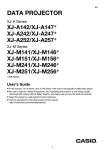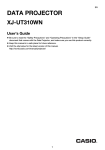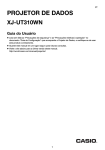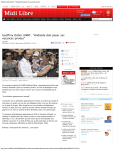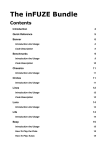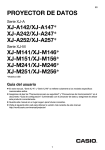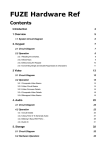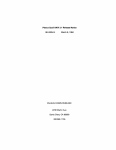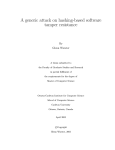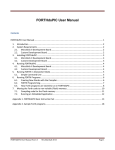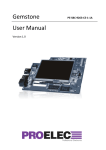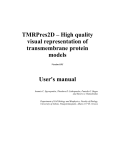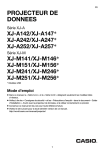Download FIGnition User Manual
Transcript
FIGnition User Manual
Contents
Introduction
1
Command Reference
2
Arithmetic / Logic
2
Parameter Stack Operations
4
Control Flow
4
Memory And I/O:
5
Data
7
Comparison.
7
Number Conversion
8
User Interface:
9
Text Processing
10
System
12
Compiler
13
Locals
15
Dictionary
16
Interpreter
16
Return Stack Operations
17
Graphics
17
Storage
18
Introduction
FIGnition contains around 200 built-in commands in its version of Forth; divided into 17
categories. The Quick Reference lists the commands that are available; the Command
Reference provides usage details for all the commands. The Programming Topics,Hardware reference and Cookbook are yet to be added.
Command Reference
Arithmetic / Logic
FIGnition has an extensive set of integer arithmetic operations. They normally work with 16-bit numbers, which are
stored in the Data Stack in internal AVR memory, but some operations handle 32-bit numbers; stored as a pair of 16-bit
numbers with the most significant 16-bits upper most in the stack. The top value of the stack is held in an AVR register
(not on the data stack) to increase performance. Most operations either operate on the top item in the stack or the top
two items in the stack, returning a single value.
Most Forth Arithmetic operations are fairly conventional; there's normal arithmetic, including unary negation and logical
operations. Some operations are included because they're fast, special cases. 1+ and 1- are faster than 1 + and 1 - .
There are a large number of division and modulus permutations of instructions in FIGnition. There are two main reasons
for this.
1.
Standard low-level division algorithms naturally return both the modulus and division result and surprisingly often
you have a use for both. Therefore it makes sense to include the combined operation.
2.
Variants of division and modulus are used extensively when converting numbers to text.
Some operation operate on two or three items on the stack, returning one or two values.
Stack Inputs
(: Return
Stack Inputs)
Command
Post-Command
inputs
Stack Effect
Action
ab
and
a&b
Returns the bitwise and of the top two items on the
stack.
ab
or
a|b
Returns the bitwise or of the top two items on the
stack.
ab
xor
a^b
Returns the bitwise exclusive or of the top two
items on the stack.
ab
<<
a << b
Returns a * 2^b; or a shifted left b times.
ab
>>
a >> b
Returns (unsigned)a / 2^b; or a shifted right b
times.
ab
+
a+b
Returns a+b.
ab
-
a-b
Returns a-b.
aL aH bL bH
d+
Lo(a+b)
Hi(a+b)
The 32-bit number a=(aH*65536+aL) is added to
the 32-bit value b=(bH*65536+bL) and the result is
stored on the top two stack items.
a
neg
-a
The top item is negated.
aL aH
dneg
Lo(-a)
Hi(-a)
The 32-bit number a=(aH*65536+aL) is negated
and the result is stored on the top two stack items.
Stack Inputs
(: Return
Stack Inputs)
Command
Post-Command
inputs
Stack Effect
Action
ab
u*
Lo(a*b)
Hi(a*b)
The 32-bit unsigned result of unsigned a* unsigned
b is calculated and stored in the top two stack
items.
aL aH b
u/
(a Mod b)
(a Div b)
The 32-bit unsigned number a=(aH*65536+aL) is
calculated. (a Mod b) and (a DIV b) are stored on
the stack; b is treated as unsigned.
a
1+
a+1
Increments a (it is 3x faster and shorter than 1 + )
a
1-
a-1
Decrements a (it is 3x faster and shoter than 1 - )
ab
*
a*b
Multiplies the signed values of a and b, returning
the result on the stack.
a
2+
a+2
Adds 2 to a (it is faster and shorter than 2 + )
a
2*
2a
Multiplies a by 2 (it is 4 times faster and shorter
than 2 * and 3 times faster and shorter than 1 <<).
-1
-1
Adds -1 to the stack.
ab
+-
-a (if b<0)
else a
Negates a if b<0
aL aH b
d+-
Lo(-a)
Hi(-a) if b<0
else aL aH.
If b<0, negates the (signed)32-bit number
aH*65536 + aL. Otherwise does nothing.
a
abs
abs(a)
Negates a if a had been -ve.
aL aH
dabs
Lo(abs(a)),
Hi(abs(a))
Negates the 32-bit signed number
a=(aH*65536+aL) if a<0
ab
min
min(a,b)
Returns the minimum of a and b.
ab
max
max(a,b)
Returns the maximum of a and b.
ab
m*
Lo(a*b)
Hi(a*b)
The 32-bit signed result of signed a* signed b is
calculated and stored in the top two stack items.
abc
*/mod
(a*b Mod c)
(a*b Div c)
Calculates signed a * signed b giving a signed 32bit result, then returns signed a*b MOD signed c
and signed a*b Div signed c
abc
*/
(a*b Div c)
Calculates signed a * signed b giving a signed 32bit result, then returns signed a*b Div signed c
aL aH b
m/
a/b
Calculates signed a=(aH*65536+aL) then returns a
divided by signed b.
ab
/mod
(a Mod b)
(a Div b)
Calculates signed a Mod signed b and signed a Div
signed b .
ab
/
a Div b
Calculates signed a Div signed b.
ab
mod
a Mod b
Calculates signed a Mod signed b.
Stack Inputs
(: Return
Stack Inputs)
Command
aL aH b
m/mod
Post-Command
inputs
Stack Effect
Action
(a Mod b)
Lo(a Div b)
Hi(a Div b)
The 32-bit unsigned number a=(aH*65536+aL) is
calculated. (a Mod b) and the 32-bit unsigned result
of (a DIV b) are stored on the stack; b is treated as
unsigned.
Parameter Stack Operations
FIGnition includes a limited set of stack operations; and importantly doesn't include pick and roll . The normal practice
with FIGnition is to use >r r and r>.
Stack Inputs
(: Return
Stack Inputs)
Command
Post-Command
inputs
Stack
Effect
Action
ab
over
aba
Duplicates the second item on the stack to the top
of the stack.
a
drop
--
Removes the top item from the stack.
ab
swap
ba
Swaps the top two items on the stack.
a
dup
aa
Duplicates the top item on the stack.
a
?dup
if a<>0, a a
else a
Duplicates the top item of the stack if it's not 0.
abc
rot
bca
Moves the third item on the stack to the top item.
ab
2dup
abab
Duplicates the top two items on the stack.
a
s->d
a sign(a)
Sign extends a to 32-bits.
Control Flow
FIgnition's Forth contains a standard set of Forth commands for loops and conditional execution.
do .. Loops are loops where you know beforehand how many times you need to repeat it.
do ... loop always loops to one less than the limit. This means that it treats loop ranges as unsigned and countdown
loops aren't possible.
do .. n +loop always loops until the counter crosses the boundary of the loop's limit. Because +loop is defined as crossing a boundary, it's possible to do create backwards loops, e.g. -10 1 do i . -1 +loop .
begin loops are loops where you want to keep looping round until a criteria is met.
begin commands condition until loops always execute at least once, because the condition occurs at the very end of the
loop, after all the commands have been executed.
begin condition while commands repeat loops test the condition before the commands are executed, and thus the
commands may be executed 0 or more times.
Stack Inputs
(: Return
Stack Inputs)
Command
limit from
do
Post-Command
inputs
Stack
Effect
--
loop
n
+loop
Action
Starts a loop beginning at from and ending at limit,
by pushing i and i' onto the return stack and then
setting i to from and i' to limit.
Increments i and causes the program to loop round
to its matching do command if the new value of i
isn't the limit.
--
leave
Adds n to i and causes the program to loop round
to its matching do command if the new value of i
didn't cross the limit.
Sets the loop counter i to the limit.
i
i
The current value of the inner most loop counter.
i'
i'
The current limit for the inner loop.
begin
Starts a begin.. until loop or a begin .. while .. repeat loop; when the loop loops, it jumps back to
here.
n
until
--
Ends a begin .. until loop. If n is 0, the program
loops back to the matching begin, otherwise it continues.
n
while
--
Handles the condition for a begin .. while commands repeat loop. If n is 0 the program continues
by executing commands all the way to the matching repeat .
repeat
n
cfa
if
Ends a begin ... while .. repeat loop by looping back
to its matching begin.
--
Tests the condition for an if commands then or if
commands else alternativeCommands then command. If the condition is true (i.e. not 0) then the
program continues executing the commands.
else
The optional middle part of if ... else ... then . If the
condition was false, the if ... else .. then continues
executing the alternativeCommands between else
and its matching then. If the condition had been
true, the action of else is to jump past the alternativeCommands to the then part.
then
The final part of an if ... then or if ... else .. then
command; where execution resumes as normal.
exec
;s
--
Executes the commands whose cfa (Code Field
Address) is on the top of the stack. @See Headers.
Returns from the current command, by popping the
return address from the top of the return stack.
Memory And I/O:
FIGnition uses both external Memory (Serial Ram) and internal memory belonging to the AVR Microcontroller. Therefore
it supports commands which read and write to both types of memory.
Byte Order: @ and ! access 16-bit values as big-endian numbers: the first byte of a var variable is the most significant
byte. External RAM is accessed for addresses > 0x8000 and Internal Flash is accessed for addresses <0x8000. With
internal RAM, the byte order is little-endian: the first byte of an internal 16-bit number is the least significant byte. This is
true for both the return stack and the data stack and matches the natural order for an AVR. Most of the time, FIGnition's
conversion from external big-endian 16-bit values and internal little-endian 16-bit values is done transparently, though
sometimes you need to check.
Block Memory Addressing: When using cmove and fill, the memory map is different. Addresses in the range 0 to
0x0FFF are treated as internal RAM addresses; addresses in the range 0x1000 to 0x7FFF are Flash memory and
0x8000 to 0xFFFF are treated as external RAM addresses. This means that it's possible to copy between all types of
memory using cmove and fill; however, the bottom 4Kb of Flash isn't accessible.
Stack Inputs
(: Return
Stack Inputs)
Command
Post-Command
inputs
Stack
Effect
addr
@
Mem[addr]
Fetches the 16-bit big-endian value at addr in external RAM (or Internal Flash)
addr
c@
Mem[addr]
Fetches the 8-bit value at addr in external RAM (or
Internal Flash)
value addr
!
--
Stores the 16-bit big-endian value at addr in external RAM
value addr
c!
--
Stores the 8-bit big-endian value at addr in external
RAM
src dst len
cmove
--
Copies len bytes of memory from src to dst. If src is
<= dst; the memory is copied from the beginning to
the end; otherwise it's copied backwards from the
end to the beginning (so that writes don't overwrite
values in src that haven't been copied yet).
src len value
fill
--
Copies len copies of the 8-bit value value to src.
addr
i@
InternalMem[addr]
Fetches the 16-bit big-endian value at addr in internal RAM
addr
ic@
InternalMem[addr]
Fetches the 8-bit value at addr in internal RAM
value addr
i!
--
Stores the 16-bit big-endian value at addr in internal RAM
value addr
ic!
--
Stores the 8-bit big-endian value at addr in internal
RAM
orVal andVal
addr
>port>
InternalMem[addr]
Performs an atomic read-write-modify operation on
a byte in internal memory. The byte is read, then
anded with andVal, then or'd with orVal and finally
written back (all with interrupts turned off). It can be
used to modify particular bits in ports without other
tasks in the system affecting the result. >port> returns the original value of the internal Memory at
addr, and thus can be used to implement rudimentary semaphore operations.
spi
n addr
+!
Action
A core SPI driver. @TODO.
--
Adds n to the contents of the external 16-bit value
at addr, storing the results in addr.
Data
FIGnition contains a number of words for creating items of data in external RAM. In addition, one dimensional array handling is supported.
[#1].
10 arr stats
1000 5 stats ! ( stores 1000 at element 5 of the array stats)
5 stats @ . ( displays element 5 of stats i.e. 1000)
[#2].
10 bytes bins
1000 5 bins c! ( stores the low byte of 1000 at element 5 of the array bins)
5 bins c@ . ( displays element 5 of bins i.e. 232)
Stack Inputs
(: Return
Stack Inputs)
Command
Post-Command
inputs
Stack
Effect
Action
n
var
name
var creates a 16-bit variable called name and sets
its value to n.
n
const
name
const creates a 16-bit constant called name and
sets its value to n.
n
allot
Allocates n bytes to the end of the current program
in external RAM. Before allot is executed, here
returns the address of the first byte to be allocated.
n
,
Allocates 2 bytes to the end of the current program
and copies n to external RAM at the original value
of here.
n
c,
Allocates 1 byte to the end of the current program
and copies n to external RAM at the original value
of here.
n
arr
name
Creates an array called name in external RAM with
n x 16-bit values allocated to it.[#1]
n
bytes
name
Creates a byte array called name in external RAM
with n x 8-bit values allocated to it.[#2].
Comparison.
Fignition contains a number of simple commands used to compare values on the stack.
Stack Inputs
(: Return
Stack Inputs)
Command
Post-Command
inputs
Stack
Effect
Action
n
0=
-1 or 0
Returns -1 if n=0 or 0 otherwise.
n
0<
-1 or 0
Returns -1 if n<0 or 0 otherwise.
ab
u<
-1 or 0
Returns -1 if unsigned a < unsigned b; or 0 otherwise.
ab
<
-1 or 0
Returns -1 if signed a < signed b; or 0 otherwise.
ab
>
-1 or 0
Returns -1 if signed a > signed b; or 0 otherwise.
Stack Inputs
(: Return
Stack Inputs)
Command
ab
=
Post-Command
inputs
Stack
Effect
-1 or 0
Action
Returns -1 if a = b, or 0 otherwise.
Number Conversion
Standard Forth has extensive number conversion commands so that numbers may be displayed in a variety of formats
and converted from a number of formats.
Setting the current number base. Forth provides two words for defining preset number bases: hex and decimal. By defining them as whole words, it avoids the problem that converting back to different number bases depends on the current
base. For example, 10 base ! would normal set the base to base 10. However, if the computer was set to base 16,
then 10 base ! would merely set the base back to 16 (because when you write 10 in base 16, it means 16).
[#1]. <#, sign, hold, #, #s and #> are used to generate formatted numbers.The process always involves starting with <#
to set up number conversion in Forth. To actually convert numbers we need to provide a double-number on the stack
(aL:aH) and numbers are always converted right-to-left; starting with the least significant digit. # converts the least significant single digit in aL:aH returning the new aL:aH . Thus, # can be used for fixed precision conversion. #s finishes off
all the remaining digits. #> finishes the number conversion returning the address and length of the string (though the
string can also be simply displayed using “. ). Hold is used to insert specific characters into the string. Finally sign is for
signed number conversion and expects sign , aL , aH to be on the stack.
For example, if n is an unsigned 16-bit value in 10ths of a second we could convert it to text with:
0 ( to make it 32-bit) <# # ( convert 10ths) asc . hold (insert decimal point) #s ( finish digits) #> type
Or if we just wanted to display a 3 digit rev counter (and we know we never need more than 3 digits):
0 <# # # # ( generate 3 digits) #> type
Would work (we don’t need the #s here).
Stack Inputs
(: Return
Stack Inputs)
ch base
Command
Post-Command
inputs
Stack
Effect
Action
base
addr
Returns the address of the current base used for
number conversion.
hld
addr
When converting a number to a string, hld returns
the address of the beginning of that string.
tib
addr
Returns the address of the Terminal Input Buffer
used for command line interpretation.
in
addr
Returns the address of the offset from the Terminal
Input Buffer for where interpretation is currently at.
hex
Sets the current number base to 16 for hexadecimal numbers.
decimal
Sets the current number base to 10 for decimal
numbers.
digit
digit
(-1 or 0)
Returns the unsigned digit's value in the current
base and -1 if ch is in the the correct range for the
base: a digit from '0' to 'base-1' or if base>9, the
last acceptable character will be a letter 'A' to
'A+base-10'
Stack Inputs
(: Return
Stack Inputs)
Command
Post-Command
inputs
Stack
Effect
text^
number
Lo(n) Hi(n)
ntype
Expects a pointer to a string as input and returns
the double-number converted from the text in the
current base followed by its type: 0 for not a number, 1 for a 16-bit integer, 2 for a 32-bit integer.
ch
hold
--
Prepends ch to the hld string.
pad
addr
The address for the end of the hld string, it's here +
0x43.
<#
Action
Begins number conversion by setting hld to point to
the pad and terminating the hld string.
aL aH
#>
addr len
Exits number conversion, by dropping the number
being built up and returning the address of the
string and its length.
sgn aL aH
sign
aL aH
If sgn<0, prepends '-' to the hld string, it doesn't
change aL or aH.
aL aH
#
Lo(a') Hi(a')
Extracts the least significant digit of
a=(aH*65536+aL) in the current base; converts it to
a character and holds it. Returns a new a, divided
by the current base.
aL aH
#s
00
Extracts all the remaining digits of
a=(aH*65536+aL) in the current base, until a'=0.
User Interface:
FIGnition provides a number of commands for outputting text and numbers; and inputting them.
Emit Notes: Two characters are treated differently. 0 emit outputs nothing and doesn't move the cursor. 13 emit outputs
a carriage return. Other characters in the range 1..15 output UDG characters 1..15. It's possible to override this behaviour by adding 256 to the character. Thus 256 emit outputs UDG 0 and 269 emit outputs UDG 13.
At Notes: In Text mode, at sets the character coordinate. In graphics mode it sets the pixel coordinate for displaying
characters and setting the blitting position, thus 8 16 at in graphics mode is equivalent to 1 2 at in text mode. In addition,
in hi-res mode at can be used twice to set the secondary pen coordinates and the primary pen coordinates for 2blt.
.hex Notes: .hex is a kernel routine which doesn't depend on the Forth system; it's much faster than . , but less flexible.
It's also useful for debugging the Forth system itself.
Pause Notes: If n<0, Pause will wait for -n frames, but will exit early if the user presses a key (it doesn't return the keypress, you'll need to use inkey to read it). A pause of 32767 pauses for almost 11 minutes (PAL) or just over 9 minutes
(NTSC).
at> Notes: at> is useful in text mode games for finding out what's on the screen at any given location, thus it's handy for
collision detection.
Stack Inputs
(: Return
Stack Inputs)
Command
ch
emit
Post-Command
inputs
Stack
Effect
--
Action
Outputs the character ch on the screen and moves
the cursor onto the next position. If the cursor
moves off the end of the screen, the screen is
scrolled (in text mode), see Emit Notes.
Stack Inputs
(: Return
Stack Inputs)
Command
xy
at
--
Sets the cursor to x y . See At Notes.
n
.hex
--
Outputs n as an unsigned hexadecimal number
preceded by '$'. See .hex notes.
key
ch
Waits for the user to press a key and returns its
character code.
inkey
ch or 0
Returns the character code of the most recent key
pressed, or 0 if no key has been pressed.
addr len
Post-Command
inputs
Stack
Effect
Action
cls
Clears the screen (in text and graphics mode)
cr
Moves the print position to the start of the next line.
type
--
space
Displays len characters starting at addr.
Displays a space character (equivalent to 32 emit).
n
spaces
--
Displays n space characters.
str
".
--
Displays the string at address str.
."
Displays the literal string a message, terminated by
a " character.
a message"
n
pause
--
Waits for n frames on the TV to pass and then continues. See Pause notes.
aL aH n
d.r
--
Displays a (which is aH*65536+aL) in a field of no
less than n digits, in the current base.
aL aH
d.
--
Displays a (which is aH*65536+aL), in the current
base.
an
.r
--
Displays a in a field of no less than n digits, in the
current base.
a
.
--
Displays a in the current base.
addr
?
--
Displays the 16-bit value at Mem[addr] in the current base.
more
--
If the display position is on the bottom row, more
waits for a keypress and then clears the screen.
xy
at>
internalAddr
Converts (x, y) to the internal Ram address in video
memory. See at> notes.
xywh
clBox
--
Clears an area on the screen w characters wide
and h characters high from (x,y).
Text Processing
FIGnition Forth supports capable string handling, which is uniform across the system. Strings are a sequence of characters terminated by a 0 byte as in standard 'C' strings. It is possible to compile in literal strings; display strings, copy, cut,
index and join strings; input strings from the user and convert between numbers and strings. Examples follow.
[#1] : stringEx1 " Hello World!" ". ; ( compile in a string, returning a pointer to it,
then display the string)
[#2] asc Hello . 72 ( 72 is the character code for 'H')
create days
" Sun" " Mon" " Tue"
" Wed" " Thu" " Fri"
" Sat"
Creates 7 constant strings holding the days of the week, which can be accessed as: n 4 * days +, e.g:
: .days 7 0 do i 4 * days + ". loop ;
Stack Inputs
(: Return
Stack Inputs)
Command
Post-Command
inputs
"
some_text"
Stack
Effect
Action
In interpret mode, compiles the string some_text
into the dictionary. In compile mode inserts code to
push the address of the string to the stack and then
compiles the string into the dictionary [#1].
bl
32
Returns the character code for the 'blank' character, i.e. 32.
tib
addr
Returns the address of the beginning of the Terminal Input Buffer
dir string^ ch
cIn"
string'
Given dir, a search direction: 1 or -1 (postincremented if 1 or predecremented if -1); string^
which points to a string and ch the character to
search for; searches string in the specified direction
for ch and returns string' the address where the
character is found or where string terminated.
string^
"len
string'
Searches forward through string for the end of the
string, returning it's address.
string^
"skipBl
string'
Searches forward through string for the first nonblank character or the end of the string, returning
its address.
buff maxLen w
h
boxed
exitCode
Interactively edits the text in buff in a screen region
at the current at coordinate of dimensions (w,h).
Editing finishes when <exe> or <cmd> are pressed
and that key code is returned on exit.
ch
word
--
Text in the tib is searched until the matching character ch is found (or the end of text or end of line is
found). The text is then copied to here.
string1 string2
"<>
difference
Compares string1 with string2 returning <0 if the
string1 < string2; 0 if the strings match; >0 if string1
> string2. If string1 only matches string2 up to the
end of string1, only the lower 8 bits will be 0.
asciiCode
Reads the following text word and returns the ascii
code of the first character in that word. [#2].
asc
aWord
srcStr dstStr
"!
Copies srcStr to dstStr, srcStr can be a string from
RAM, internal RAM or Flash. dstStr should have
enough space to store srcStr and the terminating
byte.
srcStr dstStr
"+
Concatenates srcStr to dstStr. dstStr should have
enough space to store the original string in dstStr
and srcStr.
Stack Inputs
(: Return
Stack Inputs)
Command
str n
"cut
str n
"from
buff
query
Post-Command
inputs
Stack
Effect
Action
Terminates str at offset n, thus making it n bytes
long. This is similar to left$ in Basic Note: it doesn't
check the length of str.
str'
Returns the string str starting at offset n or the end
of the string if n > str "len .
System
FIGnition provides access to a number of low-level system features.
[#1] Kern Notes: FIGnition Forth contains a number of kernel vectors, which are pointers to useful system routines or
addresses. If n is >0 a big-endian kernel vector is returned; otherwise a little-Endian kernel vector is returned. The following vectors are defined in the section on Kernel vectors.
[#1] SysVars Notes: FIGnition Forth contains a number of system variables in internal RAM. These are:
typedef struct {
byte *gCur;
// In Text mode, a pointer to the print position.
// In Hires Mode, Y coord (byte) , clipTop (byte).
byte gCurX;
// The Current X coordinate.
byte buff[8];
// A Temporary buffer used for cmove.
byte gKScan;
// The Current raw key scan.
byte *stackFrame; // The loc Frame pointer.
byte clipLeft; // The Blitter's left clip coordinate.
byte clipRight; // The Blitter's right clip coordinate.
byte clipBot; // The Blitter's bottom clip coordinate.
byte savedX;
// The previous x coordinate from an at command.
byte savedY;
// The previous y coordinate from an at command.
} tSysVars;
[#1] sp0 Notes: The starting address of the data stack can be used to reset the data stack, by executing sp0 sp i! .
Stack Inputs
(: Return
Stack Inputs)
Command
Post-Command
inputs
Stack
Effect
Action
n
kern
vec
Returns kernel vector n. See [#1].
vram
internalAddr
Returns the address of text mode video ram.
clock
internalAddr
Returns the address of the frame counter, a 50Hz
clock for PAL systems and a 60Hz clock for NTSC
systems.
sysvars
internalAddr
Returns the address of the kernel system variables
in internal RAM. See [#2].
sf
internalAddr
The address of the loc stack frame.
rp
internalAddr
The address of the return pointer in internal RAM;
this is the same as the AVR's stack pointer.
sp
internalAddr
The address of the data stack pointer in internal
RAM; this is the same as the location of the AVR's
xh:xl rregister pair.
Stack Inputs
(: Return
Stack Inputs)
Command
Post-Command
inputs
Stack
Effect
Action
sp0
internalAddr
The starting address of the data stack [#3].
warning
addr
A Forth system variable. If it's set to >=0; an error
will cause execution to return to the command line
interpreter, otherwise, an error will cause execution
to restart using abort.
dp
addr
Returns the address of here, i.e. the address
where the next byte will be allocated.
current
addr
Returns the address of latest, i.e. the address of
the most recently defined command.
abort
Aborts the currently running command, resets the
data stack and then restarts the command line interpreter by executing quit.
quit
The interpretation loop: repeatedly reads a command line and executes it.
cold
Restarts the FIGnition Forth interpreter from
scratch, displaying the FIGnition logo and then initializing Forth variables.
Compiler
The working of FIGnition's Forth compiler is exposed to the user so that you can override the compiler's normal operation; define commands that define commands; explore the structure of compiled commands and even extend the compiler itself.
[compile] Example: : compIf [compile] if ; . Normally if expects to be part of an if ... [ else ... ] then statement
and the if part is followed by a branch to the following then (or else). Here we compile in just the token for if.
literal Example: : exLiteral [ 100 ] literal ; This is equivalent to : exLiteral 100 ; . The purpose of
literal is so that you can perform complex literal calculations within a definition, and then just compile the result into definition rather than having the definition having to calculate it every time it's run.
[#3]: ?pairs is used to parse constructs such as begin ... until or if ... else .. then . These constructs
are always immediate words which get executed even in compile mode; because their compilation process is more complex than merely appending their execution address. The first part of a construct (when being compiled) will push an
identifier. When the next part of the construct is compiled, the compilation process checks the identifier matches the expected identifier using ?pairs and generates a "Mismatched" error otherwise.
[#4]: compile is used within an immediate colon definition to compile the following word whenever that colon definition
is used. For example: : testComp compile ?dup ; immediate would cause ?dup to be compiled into the dictionary whenever testComp was used in another definition. So, for example: test2 testComp ; would in fact generate
: test2 ?dup ; .
[#5]: <builds ... does> defining words, one of Forth's most powerful constructs. These are mostly used for type
definitions, called 'definers' in Forth. They are used in the form:
: definerCommand <builds CompileTimeExecution does> RunTimeExecution ;
and the definerCommand is then used to create further definitions with a pattern and behaviour defined by definerCommand. For example:
: array1D <builds allot does> + ;
creates a definer called 'array1D' which can then be used in the form:
10 array1D x and 100 array1D y
to create a 1 dimensional array called x with 10 elements and another 1 dimensional array called y with 100 elements. The <builds allot part is executed whenever array1D is run to create an actual array of data:
<builds creates the header and the allot picks up the size of the array and allots the size number of bytes. Finally does> makes the array's cfa point to the code following does> . Later, when the named array (e.g. x or y in
our case) is executed, in the form: offset arrayName (e.g. 5 x) the address of the data for x is put on the stack
and added to the offset giving the address of the element.
Stack Inputs
(: Return
Stack Inputs)
[runtime] n
Command
Post-Command
inputs
[compile]
command
Stack
Effect
Action
An immediate command that reads the following
word and forces it to be compiled (thus you can use
it to compile a command even if it would be interpreted).
literal
--
An immediate command that compiles the top
value on the stack into the program at the current
point.
state
addr
The address of the current compilation state. Can
be used by immediate commands to determine if
the computer is currently in compile mode ( state @
isn't 0) or interpreting ( state @ is 0) and thus behave differently.
here
addr
The address of the first free location after the dictionary.
lfa
lfa>cfa
cfa
Converts a Link Field Address into a Code Field
Address.
lfa
lfa>ffa
ffa
Converts a Link Field Address into a Flag Field
Address.
lfa
lfa>nfa
nfa
Converts a Link Field Address into a Name Field
Address (which is a conventional string).
latest
addr
The address of the most recently defined command.
ab
?comp
Generates "Wrong State" error through ?error if
Forth isn't in compile mode. It's used within the
definition of words that can only be compiled, but
not interpreted.
?pairs
If a ≠ b, then a "Mismatched" error is generated
using ?error [#3].
:
err? errText^
?error
name
Creates a new definition called 'name' and enters
compilation mode.
If err? ≠ 0, generates an error: it executes abort if
warning < 0; otherwise if Forth is compiling it first
displays the current word being compiled; then in
all cases it displays the errText^ error message
followed by the most recently read word which is at
here.
Stack Inputs
(: Return
Stack Inputs)
cfa
Command
Post-Command
inputs
Stack
Effect
Action
immediate
Is used at the end of a compiled definition (just
after ; ) to modify its header so that it becomes an
immediate command.
x,
Compiles a cfa. If the code is <256; a single byte is
compiled, otherwise a 16-bit word is compiled.
compile
Compiles the next word in the instruction stream
into the dictionary [#4].
;
Terminates a definition and returns to immediate
mode.
[
Enters immediate mode.
]
Enters compile mode.
smudge
Toggles the invisibility flag for the latest definition
so a previous definition of the same definition can
be seen.
create
name
Creates a new definition which returns its own pfa
when executed.
<builds
Used as part of a defining word to create the defining word's header. [#5].
does>
Used as part of a defining word to create the defining word's run-time behaviour [#5].
(
text )
Skips subsequent text all the way until the next ')'.
Locals
FIGnition Forth provides full support for persistent stack frames. The purpose of stack frames is to provide a means of
defining local variables which can be accessed quickly and compactly; and can be allocated and deallocated dynamically. FIGnition Forth stack frames have persistent scope in that called functions have access to the stack frame of the
calling function. Here's a short example:
: sfDisp
l> 0 dup . ( display the stack frame item at offset 0)
1+ l> 0 ( increment the item at offset 0)
12 >l 2 ( store 12 at stack frame offset 2)
;
: sfExample
4 locs ( allocate a stack frame with 4 bytes)
17 >l 0 ( store 17 at offset 0)
sfDisp
l> 2 . ( display the stack frame item at offset 2)
loc; ( deallocate and return)
FIGnition stack frames are quick to access, because they use internal RAM and are compact, because accessing them
only requires 2 bytes ( the (>l) or (l>) primitive and a one byte offset). You can combine stack frames and parameter
stack access.
Stack Inputs
(: Return
Stack Inputs)
Command
n
locs
Allocates n bytes on the stack frame.
: returnAddr
loc;
Deallocates the current stack frame and returns
from the current procedure.
n
Post-Command
inputs
l>
value
>l
value
Stack
Effect
sf[value]
Action
Fetches the item on the stack frame offset by value
bytes.
Stores n in the item on the stack frame offset by
value bytes.
Dictionary
FIGnition Forth provides a number of (immediate) words for managing the dictionary: finding commands within the dictionary; listing commands and forgetting commands.
[#1]: vlist examples. For example, vlist cl would list all the commands beginning with 'cl' and by default this will
be: clBox, clock, cls, clip . vlist by itself lists all the words in the dictionary.
Stack Inputs
(: Return
Stack Inputs)
Command
Post-Command
inputs
Stack
Effect
Action
find
name
lfa or 0
Searches backwards for the command name in the
dictionary starting with the most recently defined
command, returning its link field address (lfa). If the
word cannot be found, 0 is returned.
vlist
prefixName
Lists all the commands in the dictionary that begin
with prefixName [#1] .
forget
name
Finds name in the dictionary and deletes that
command and every subsequently defined command from the dictionary (if the comand is in RAM).
Interpreter
Forth provides a number of key words used for interpreting the command line.
[#1]. "run and interpret can be used to make Forth programmatically execute text. If the tib is made to point to the text in
question, "run will execute the whole line and interpret a single command.
Stack Inputs
(: Return
Stack Inputs)
Command
Post-Command
inputs
Stack
Effect
Action
text^ delim
enclose
Given a text pointer and a delimiter, searches
through the text until the delimiter is found, returning the pointer to the end of the text of the delimiter.
Enclose also stops if the end of the text is found (a
0 character) or any character code below 14 (so
<cr> counts as an automatic delimiter too).
"run
Repeats interpret until the entire input text in the tib
has been interpreted. [#1]
Stack Inputs
(: Return
Stack Inputs)
Command
Post-Command
inputs
Stack
Effect
interpret
Action
Interprets a single command in the tib. The next
word in the tib is looked up in the dictionary. If it can
be found it is executed (in immediate mode) or
compiled (in compile mode). If it can't be found, it is
tested to see if it's a number and if so, pushed onto
the stack (in immediate mode) or compiled (in
compile mode). If it can't be found at all, an "Whats"
(syntax) error is executed and Forth returns to the
command line. [#2]
Return Stack Operations
FIGnition Forth has a number of simple words that operate on the Return stack.
FIGnition Forth programs use the return stack extensively, because it (deliberately) lacks commands to access more
than the top 3 elements of the data stack (those these can be implemented). The general principle is that if the data
stack contains, for example [ a b c d e] and access to a b c is required we would first execute >r >r so that the stacks
are: [ a b c : d e ] and when finished execute r> r> to shift them back. The advantage is that a, b, and c retain the same
relative positions, which makes stack manipulation less error-prone and four elements a .. d are easily accessible.
[#1]: r note: r can be used to access the outer loop value in a pair of nested do .. loops (in other Forths this would
be done using the command j ). This is because FIGnition Forth stores the inner counter and limit of a do .. loop in
fast registers, but not on the return stack; instead the previous counter and limit are pushed on the return stack; thus the
previous do ... loop's counter will be the top item and can be accessed via r.
Stack Inputs
(: Return
Stack Inputs)
Command
Post-Command
inputs
Stack
Effect
Action
:n
r
n:n
Copies the number on the top of the return stack to
the data stack. [#1]
n
>r
:n
Moves the value on the top of the data stack to the
return stack.
:n
r>
n:
Moves the value on the top of the return stack to
the data stack.
Graphics
FIGnition Forth provides core graphics commands to plot lores and hires images in a variety of plotting modes and blit
bitmaps to the hires screen.
[#1], 2Blt Note: 2blt expects at to be used twice, first to provide the tile# coordinates and secondly for the tile2# coordinates. For example, 10 10 at 30 30 at 0 $1010 4 $1010 2blt would move a 16x16 pixel sprite from (10,10)
to (30,30); using the bitmap at tile 0 for the first image and the bitmap at tile 4 for the second image.
[#2]. Pen. The Default plot mode is 1.
Stack Inputs
(: Return
Stack Inputs)
Command
xy
plot
Post-Command
inputs
Stack
Effect
Action
Plots a point in the current pen mode in either LoRes or HiRes pixels.
Stack Inputs
(: Return
Stack Inputs)
Command
Post-Command
inputs
Stack
Effect
Action
bitmap dim
tile#
tile
This copies the bitmap whose dim is
height*256+width pixels to the tile buffer starting at
tile tile#.
tile# dim
blt
Blits the bitmap starting at tile tile# with dimensions
dim [height*256+width pixels] to the frame buffer at
the current at location, in xor mode. Afterwards, the
graphics pen increments width pixels.
tile# dim tile2#
dim2
2blt
Blits the bitmap starting at tile tile# with dimensions
dim [height*256+width pixels] to the frame buffer at
the secondary at location, in xor mode; then blits
the bitmap starting at tile tile2# with dimensions
dim2 [height2*256+width2 pixels] to the frame
buffer at the primary at location. Afterwards, the
graphics pen’s primary at location is incremented
by width pixels.See Note [#1].
tile# dim xrep
yrep
blts
Blits the bitmap starting at tile tile# with dimensions
dim [height*256+width pixels] to the frame buffer at
the current at location, in copy mode. The blit is
repeated xrep times along the x-axis and yrep
times along the y-axis. Afterwards, the graphics
pen is left at the previous coordinates +
(width*xrep,height*(yrep-1)).
dx dy
clip
Defines the clip rectangle for which blitting has an
effect. This clip rectangle starts at the current at
coordinates and has dimensions (dx,dy) pixels.
mode
pen
Defines one of 4 plotting mode for plot operations:
0 = Move (no plotting is done), 1= Plot (white pixels
are plotted); 2=Erase (black pixels are plotted); 3 =
Xor (black pixels become white and vice-versa).[#2]
mode
vmode
Defines the graphics mode: 0 for 25x24 Text mode
(with lo-res pixels; UDGs, but no blitting) 1 for
160x160 Graphics mode (with hi-res pixels; blitting,
but no UDGs).
Storage
FIGnition Forth provides commands to read, write, copy and load (and interpret) blocks of flash storage.
[#1] blk> Notes: Block numbers in the range 16384 to 32767 actually read 256b from the physical page block#-16384. In
addition, negative block numbers read a block from EEPROM, but treat it as though the block number was the negative
of the given number.
[#2] loading Notes: load (and loads) are recursive; blocks loaded by load or loads can load other blocks and loading resumes at the correct place when the subordinate blocks have been loaded.
Stack Inputs
(: Return
Stack Inputs)
Command
block#
blk>
physPage
block#
>blk
blk#
Post-Command
inputs
Stack
Effect
physPage
Action
Reads external flash block block# into external
RAM at address -512. Returns physPage, the
physical page in external Flash that would be used
if >blk was used to write the block back.[#1]
Writes 512 bytes of external RAM from address
-512 into external flash block block, whose physical
page is physBlock (this should be the physical
page returned by blk>).
n
Returns the most recent block number read by blk>
n
load
Loads block n into external RAM and interprets
it.[#2]
n len
loads
Loads len blocks starting at block n into external
RAM, interpreting each block as it is loaded.[#2].
src dst
cp
Copies one block from block src to block dst. If src
is negative, then the block is read from EEPROM.
n
edit
Loads block n then enters the editor. Editing block
n if n<0 loads from EEPROM then treats it as editing block -N.A.M.



















